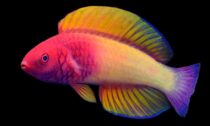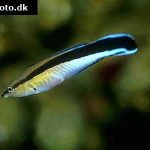
A rainbow-coloured fish that lives on “twilight zone” reefs off the Maldives has finally been recognised as a new species, more than two decades after its discovery. The rose-veiled fairy wrasse (Cirrhilabrus finifenmaa) was formally described last week in the journal ZooKeys, after years of research. The wrasse, which can grow up to 7 centimetres long, lives on reefs found 50 to 150 metres beneath the surface of the Indian Ocean.
It was first collected in the 1990s but was initially thought to be an adult version of Cirrhilabrus rubrisquamis, a fish from the Chagos Archipelago island chain, 1,000 kilometres further south.
As part of an initiative called Hope for Reefs, scientists from the California Academy of Sciences, University of Sydney, Maldives Marine Research Institute (MMRI), and the Field Museum collaborated on the discovery.
“What we previously thought was one widespread species of fish, is actually two different species, each with a potentially much more restricted distribution,” said lead author and University of Sydney doctoral student Yi-Kai Tea.
“This exemplifies why describing new species, and taxonomy in general, is important for conservation and biodiversity management.”
Despite only now being formally described, there are fears the fish is already being exploited through the fish-owning trade.
Luiz Rocha, co-director of the Hope for Reefs initiative, said the aquarium hobbyist trade threatened species not yet described.
“Though the species is quite abundant and therefore not currently at a high risk of over-exploitation, it’s still unsettling when a fish is already being commercialised before it even has a scientific name,” he said.
“It speaks to how much biodiversity there is still left to be described from coral reef ecosystems.”
The rose-veiled fairy wrasse is also the first new species to be formally described by a Maldivian researcher.
Study co-author and MMRI biologist Ahmed Najeeb said the study was a major success for scientists from the country.
“It has always been foreign scientists who have described species found in the Maldives without much involvement from local scientists, even those that are endemic to the Maldives,” he said.
“This time it is different, and getting to be part of something for the first time has been really exciting, especially having the opportunity to work alongside top ichthyologists on such an elegant and beautiful species.”












Social Profiles